Sowing grain sorghum early: are we reducing risk and increasing opportunities?
Take home messages
- Grain sorghum can be sown earlier than traditionally recommended in north west NSW
- Sowing sorghum earlier than the traditional 16 – 18 °C soil temperature recommendation is possible without negatively impacting on crop establishment and grain yield. As soil temperatures decrease, plant establishment percentages and the time to emergence increase
- Defining the minimum soil temperature required is still tenuous as temperatures are variable in the late winter/early spring and the risk of mild and severe frosts is still present
- ’Winter’ sown sorghum achieves earlier flowering and harvest times and subsequently increases the fallow length to the next crop, allowing increased opportunity for double cropping.
Introduction
The traditional sowing window for grain sorghum in northern NSW has been challenged in recent years by increasing climate variability predisposing the crop to heat and moisture stress during the critical stages of flowering and grain filling. The impacts have been devastating; missed sowing opportunities, crop failure, reduced yields and grain quality with ultimately reduced returns to growers.
Similar to the changes we have seen in wheat sowing time, incremental changes to the time of sowing of sorghum crops is occurring. Traditionally, the recommendation was for soil temperatures to be 16-18°C and rising at 8 am for three days and also beyond the period of peak frost risk before we should contemplate planting grain sorghum. However, in recent years, particularly 2018-19, many crops were sown when soil temperatures were closer to 14°C, especially in the Moree region where a missed winter crop and continuing dry conditions were driving the need for cash flow.
Since 2017, GRDC, University of Queensland, NSW DPI and QDAF have partnered in a research program to test the boundaries of sowing sorghum earlier and measuring the impacts on plant establishment, crop development, grain yield and quality. Research trials have been conducted from Emerald in central Queensland, southern Qld, Moree and south to the Liverpool Plains in northern NSW.
This series of experiments were designed to deliver a data set to define how early sorghum can be planted in each of these environments and what are the potential benefits and risks from adopting this strategy of ’winter sown sorghum‘. The experiments considered both the actual sorghum crop as well as the follow-on impact on crop rotation intensity and even the possibility of ratooned sorghum.
This paper includes results relevant to the Mungindi region, including two trials established in 2019-20 at “Bullawarrie” and “Morialta” as well as results from a harvested trial at Moree in the 2018-19 season. Two other sites, not discussed here, were sown in the 2019-20 season at Moree and Breeza. Site details for the 2019-20 season are outlined in Table 1.
2019/20 season
Two trial sites were established in the 2019/20 season in the Mungindi region. Both of these sites were established using post sowing drip irrigation due to the lack of rainfall.
All of the sites established well, however due to the continuing drought conditions the trials did not survive beyond the vegetative stages.
The watering at establishment allowed collection of a good set of establishment data from both sites, however grain yield and in crop biomass data was not able to be collected.
Each of the trial sites included 2 times of sowing, with the first time of sowing (TOS) aimed to occur when soil temperatures reached 12°C. A total of 9 hybrids were included at each site sown at four different plant populations (Table 2).
Table 1. Site characteristics for three sorghum time of sowing trials sown during the
2018/19 and 2019/20 season
Time of sowing (TOS) | Sowing date | Soil temp. at 8am# | PAW Soil water## at sowing (mm) to 120 cm | In-crop rainfalla | PSb Irrigation* | PE Irrigationb (mm)* |
|---|---|---|---|---|---|---|
2019-20 | ||||||
“Bullawarrie” Mungindi, QLD (dryland) | ||||||
1 | 22 & 23 July | 7.7 at sowing 9.3 average for following 7 days (Tinytag) | 19 | 10 | 33 | 33 |
2 | 2 & 3 Sept | 11.5 at sowing 14.1 average for following 7 days (Tinytag) | 43 | 10 | 33 | - |
“Morialta” Mungindi, NSW (dryland) | ||||||
1 | 30 July | 9.8 at sowing 4.7 average for following 7 days | 105 | 12 | 33 | 33 |
2 | 10 Sept | 5.9 at sowing 6.4 average for following 7 days | 227.12 | 12 | 33 | - |
2018-19 | ||||||
“Ponjola” Moree, NSW (dryland) | ||||||
1 | 7 & 8 Aug | 12.3 | 97.5 | 199.7 | 33* | - |
2 | 11 & 12 Sept | 17.1 | 112.8 | 153.2 | - | - |
3 | 27 Sept | 18.9 | 115.7 | 153.2 | - | - |
#Average soil temperature (°C) at 8 am at sowing depth for seven days after sowing
##Soil water (mm, 0-1.2 m) at the time of sowing
* Bore water was applied post sowing using dripper lines to ensure even establishment due to dry seedbed moisture conditions. Additional in-crop watering was applied using the same method to try and prevent trial failure.
a – in-crop rainfall current to 16th January 2020.
b - PS = post sowing, PE = post emergence
Table 2. Description of sowing dates, target populations, row spacing and hybrids treatments in
2018-19 and 2019-20.
Time of sowing (TOS) | Target plant population (pl/m2) | Row spacing (m) | Hybrids |
|---|---|---|---|
2019-20 | |||
“Bullawarrie” Mungindi, QLD (dryland) | |||
1 | 3 6 9 12 | 1.5 m solid | A66, A75, Agitator, Cracka, HGS114, MR Taurus, MR Buster, Sentinel IG |
2 | |||
“Morialta” Mungindi, NSW (dryland) | |||
1 | 3 6 9 12 | 1.5 m solid | A66, A75, Agitator, Cracka, HGS114, MR Taurus, MR Bazley, MR Buster, Sentinel IG |
2 | |||
2018-19 | |||
“Ponjola” Moree, NSW (dryland) | |||
1 | 3 6 9 12 | 1.0 m solid | MR Buster, MR Apollo, MR Taurus, Agitator, Cracka, HGS114, A66, G33 |
2 | |||
3 | |||
Results and discussion
“Bullawarrie” Mungindi – 2019/20
There was quite a bit of fluctuation in soil temperatures in the weeks following TOS 1 (Figure 1). This was also accompanied by some cold temperatures which did not result in plant death. Some minor signs of frosting were noted.
The first plant counts were recorded 22 days after sowing from TOS 1 (22 July). Plant counts were then conducted each week until the trial succumbed to the drought. No rainfall fell for 3 months following sowing.
TOS 2 was quicker to emerge, with the first plant counts occurring 15 days after sowing. Time of sowing had a significant impact on plant establishment. TOS 2 had better establishment than TOS 1 (Figure 2).
With the exception of the lowest population of 3 plants/m2, there was a significant difference in establishment between the different target plant populations (Figure 2). An incremental increase in the rate of seed sown in TOS 1 was required to achieve similar establishment as with a lower seed rate in TOS 2. There was also difference between the establishment of hybrids, with the variety Agitator having the lowest plant populations (data not shown).
Plants continued to emerge over the weeks following sowing and then started to die due to the lack of moisture. The maximum emergence was recorded at the second plant count which was either 25 or 31 days after sowing (TOS 1 or 2 respectively).
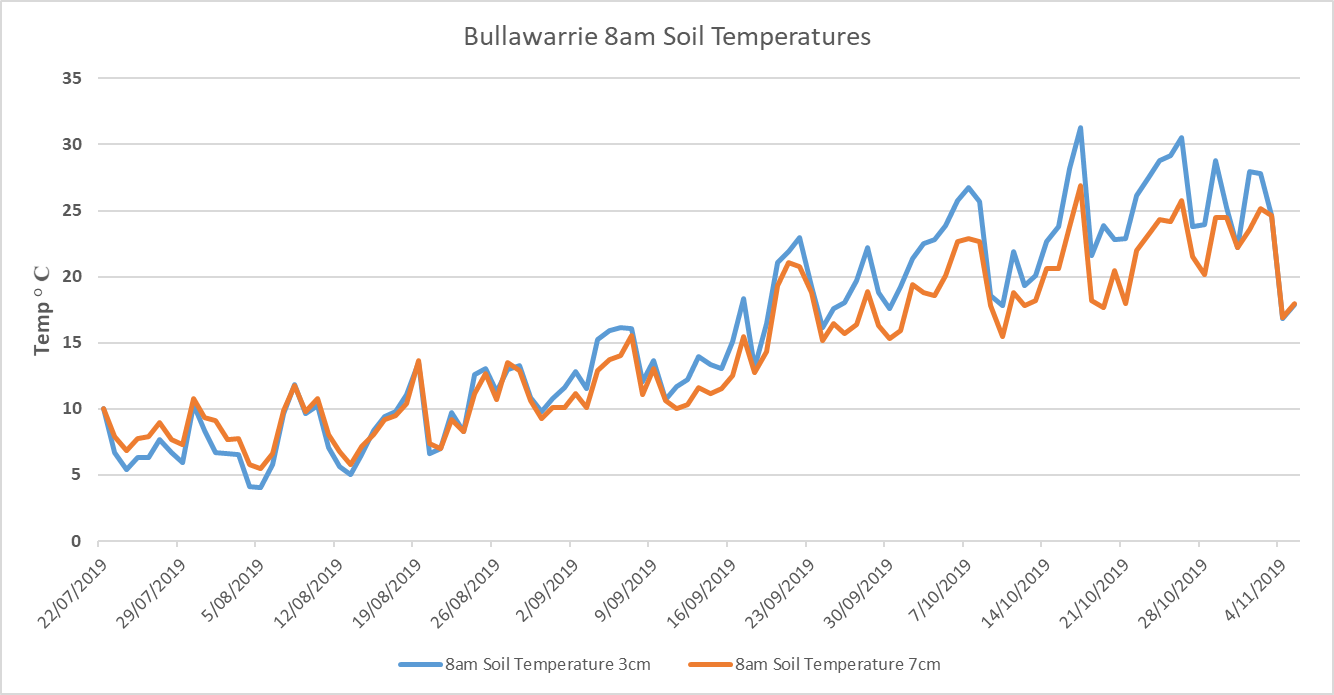 Figure 1. Soil temperatures around sowing at "Bullawarrie" - 2019
Figure 1. Soil temperatures around sowing at "Bullawarrie" - 2019
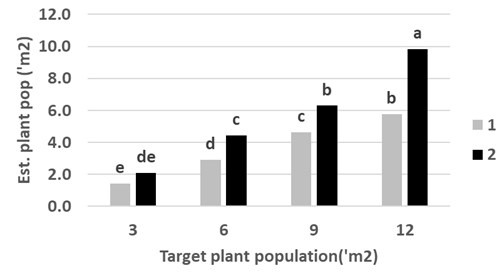
“Morialta” Mungindi – 2019/20
The first plant emergence counts were recorded 29 days after TOS 1(30July). This was longer than the time taken for emergence at “Bullawarrie” due to a cold snap and declining soil temperatures below the 12°C which had been targeted (data not shown).
Except with the lowest target plant population of 3 plants/m2, establishment from TOS 1 was statistically comparable to the higher target population at TOS 2 (Figure 3). For example, the TOS 1, 12 plants/m2 treatment was the same as 9 plants/m2 at TOS 2.
Therefore, while TOS 1 still achieved a commercial plant population, the establishment losses were higher from sowing at much colder temperatures (4.7°C for the 7 days following sowing) than waiting and sowing at TOS 2 (6.4°C for the 7 days following sowing; Table 1).
Plants continued to emerge over the weeks following sowing and then started to die due to the lack of moisture. No plant deaths were recorded as a result of frost at this site (data not shown). Maximum emergence was recorded at the second plant count which was either 37 or 20 days after sowing (TOS 1 or 2 respectively).
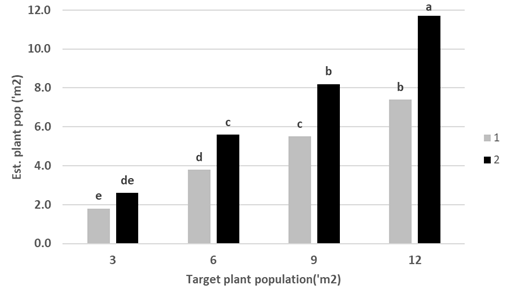
2018/19 season
“Ponjola” Moree – 2018/19
Plant establishment
The first time of sowing (TOS) occurred under dry seedbed conditions. To help ensure even establishment at the desired soil temperature, a total of 33 mm of water was applied one-week post sowing using dripper lines. The first establishment counts which recorded plants emerging were taken on the 31st August, 3 weeks post sowing and 2 weeks post watering. Plants emerged slower under TOS 1 than TOS 2 and TOS 3 which had more even and quicker establishment.
There was no impact of time of sowing on any of the final established plant populations, except the 12 plants/m2 treatment which established more plants at later TOS (Table 3).
Table 3. Impact of time of sowing time on mean plant establishment (plants/m2 established) versus target population at “Ponjola”
Target plant population | TOS 1 | TOS 2 | TOS 3 |
|---|---|---|---|
3 | 2.44 f | 2.63 f | 2.77 f |
6 | 5.22 e | 5.23 e | 5.34 e |
9 | 7.60 d | 8.32 cd | 8.35 cd |
12 | 8.94 c | 10.80 b | 11.83 a |
L.s.d: 1.02, P<0.05 | |||
There was an interaction between TOS and hybrid. Comparing across times of sowing, Agitator had the poorest establishment at nearly all TOS. TOS 2 and TOS 3 had improved establishment for nearly all hybrids when compared to TOS 1, however differences were not always statistically significant (data not shown).
Did sowing earlier impact on flowering?
There was a significant impact of sowing time, population and hybrid on the number of days taken to reach 50% flowering.
Sowing timing had a significant impact on days to flowering; the earlier we sowed, the longer the time taken to reach flowering. TOS 1 took an average of 106 days to reach 50% flowering, which reduced to 82 days for TOS 2 and 75 days for TOS 3.
Delaying sowing from TOS 1 to TOS 2 (a period of 4 weeks); reduced the time to 50% flowering by 24 days. The days to flowering difference between TOS 2 and TOS 3 was much smaller, only 7 days, even though there was a 16-day difference in sowing time.
In TOS 1, the slowest hybrid to reach 50% flowering was MR-Apollo at 115 days, and the quickest was Agitator at 99 days, a spread of 16 days over the eight hybrids examined. In contrast by TOS 3, MR-Apollo flowered in 81 days, while Agitator was 70 days, a difference of 11 days. Agitator was consistently the quickest and MR-Apollo consistently the slowest of the hybrids tested to reach 50% flowering (Figure 4).
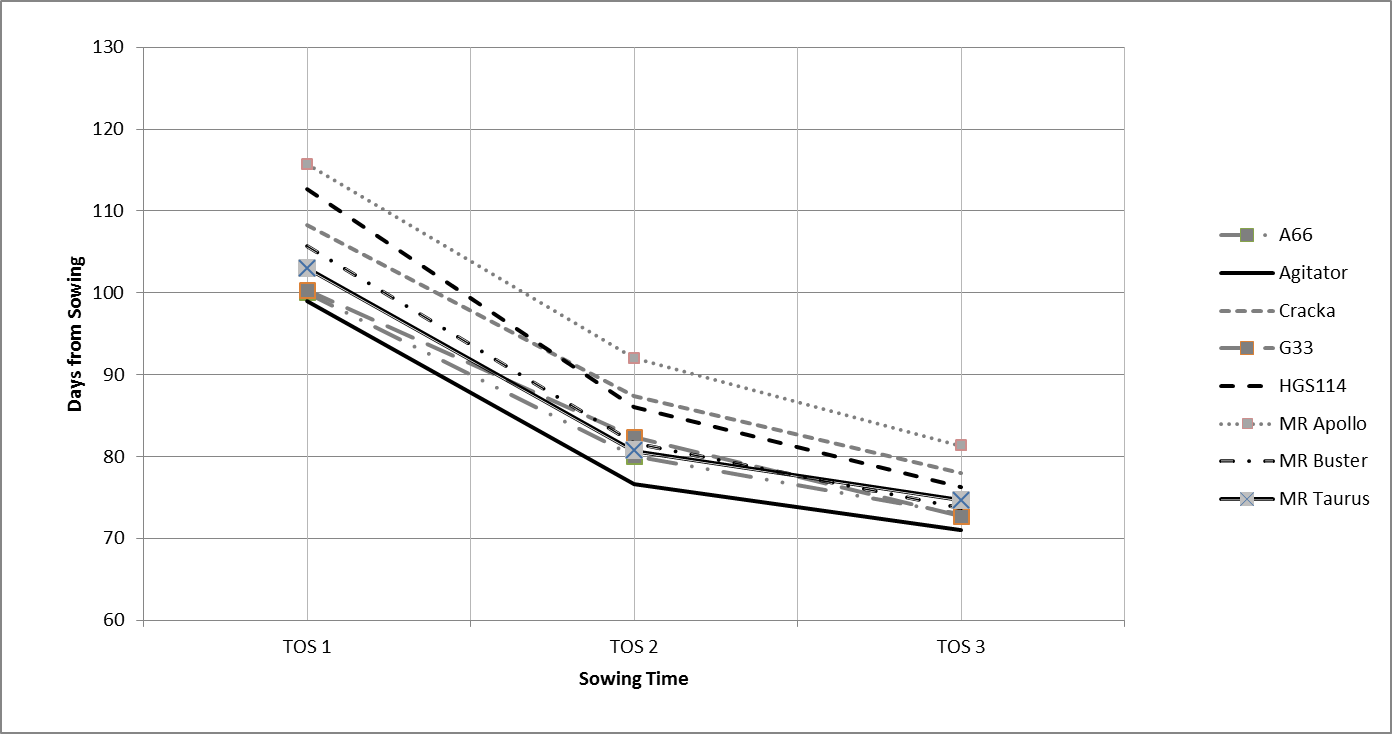 Figure 4. Days to 50% flowering at "Ponjola" for 6 plants/m2 target population.
Figure 4. Days to 50% flowering at "Ponjola" for 6 plants/m2 target population.
TOS 1 moved the flowering window for all hybrids forward by around three weeks compared to sowing at the recommended soil temperature (TOS 3). This meant flowering was completed prior to the onset of very high temperatures at the beginning of December (Figure 5).
 Figure 5. The flowering windows for TOS 1, TOS 2 and TOS 3 at "Ponjola" Moree in 2018-19
Figure 5. The flowering windows for TOS 1, TOS 2 and TOS 3 at "Ponjola" Moree in 2018-19
What was the impact on grain yield and quality?
The site mean yield was 1.78 t/ha at “Ponjola” in 2018-19. There was a significant interaction between time of sowing and hybrid yield (Figure 6). Plant population did not have a significant impact on grain yield. TOS 1 was the highest yielding at 2.14 t/ha. There was no significant difference in yields achieved between TOS 2 and TOS 3 being 1.51 and 1.68 t/ha respectively.
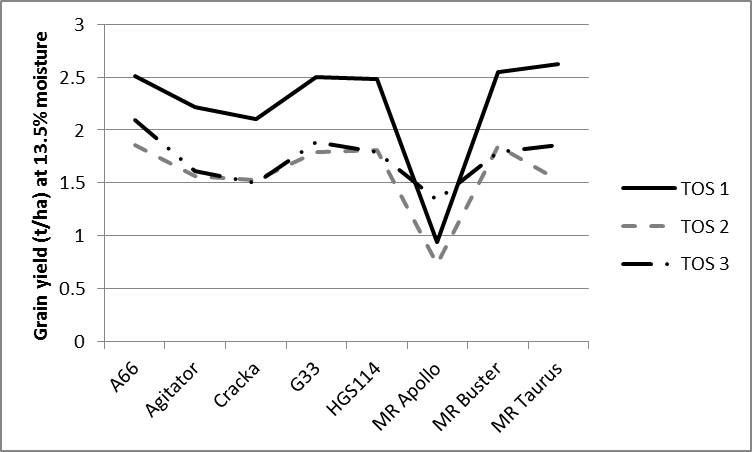 Figure 6. Grain yield at three times of sowing (TOS) at "Ponjola" Moree in 2018-19
Figure 6. Grain yield at three times of sowing (TOS) at "Ponjola" Moree in 2018-19
Grain protein achieved was significantly less at TOS 1 (10.7%) compared to the TOS 2 and TOS 3 planting times at 11.1% and 11.2% respectively. However, all grain proteins were still at an acceptable level to show that nitrogen was not limiting yield.
Screenings were impacted by TOS, population and hybrid. TOS 1 had significantly lower screenings at 10.0% compared to TOS 2 at 16.6% and TOS 3 at 17.9%. The hybrid interaction was also significant, with Agitator averaging the lowest screenings at 10.5%, while G33 and MR-Buster had the highest between 18-19%. The 12 plants/m2 target population was the only treatment to show significantly higher screenings at 15.9%, while all other target plant populations were between 14-15%, when averaged across hybrids and sowing times. This means that only TOS 1 met the sorghum 1 standards for screenings.
Test weights were generally low. No hybrid averaged the required test weight to achieve grade 1 sorghum (>71 kg/hL). The only treatment to achieve sorghum 1 was Cracka at TOS 3 with 71.3kg/hL (data not shown).
Conclusions
While only one season of establishment data has been collected in the Mungindi region, the conclusions reached are in line with the previous season’s data at other sites in northern NSW. It is possible to establish ‘winter sown sorghum’ at lower than recommended soil temperatures, as long as there is acceptance that reduced establishment percentages and slower emergence will result. Reduced establishment can be compensated for by increasing the sowing rate.
Sowing earlier moved the flowering and grain fill periods forward in experiments conducted near Moree. This has also allowed some avoidance of additional heat at flowering and grain filling, as well as completion and harvest of the crop without the need for drying. The earlier sowing times have also provided higher yields in most previous seasons.
There is still an inherent risk of frost (either killing or mild) from sowing earlier than traditionally recommended. The exact details of how cold the temperature needs to be to cause significant plant death still remains undefined.
The earlier sowing time of sorghum also provides an opportunity for greater cropping intensity in the system as harvest is brought forward, thus allowing the fallow recharge period to commence earlier than normal. This increases the chances of planting a double crop such as chickpea into a profile with more plant available soil water compared to a traditional sorghum sowing time.
Acknowledgements
The research undertaken as part of this project is made possible by the significant contributions of growers through both trial cooperation and the support of the GRDC, the author would like to thank them for their continued support.
In particular the support of: Andrew Earle “Bullawarrie” Mungindi, Tom & Melissa Greentree “Morialta” Mungindi, Michael Brosnan, Alexandra McDonnell and the team at B&W Rural Mungindi, Geoff Manchee & JR McDonald “Bogamildi” and “Ponjola” Moree, and Rob Holmes, Alex Trindall and Liz McDonald, HMAg is gratefully acknowledged.
We would also like to acknowledge the technical support of Delphi Ramsden, Lucy Loveridge, Paul Murphy, Mathew Dunn, Simon Tydd all from NSW DPI. Thanks to Steve Simpfendorfer for editing assistance.
Contact details
Loretta Serafin
NSW Department of Primary Industries, Tamworth
4 Marsden Park Road, Calala
Ph: 0427 311 819
Email: loretta.serafin@dpi.nsw.gov.au
GRDC Project Code: UOQ 1808-001RTX,
Was this page helpful?
YOUR FEEDBACK
